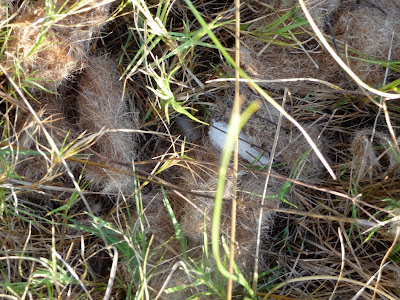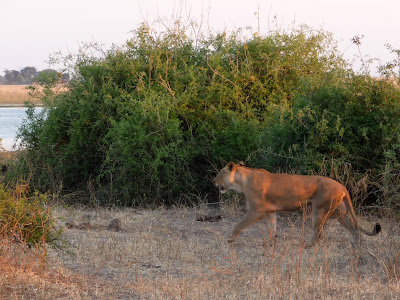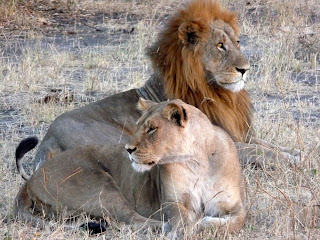 We experienced three very different levels of camping, from high end to basic. Our first two nights, we were treated like royalty. Our "outfitter" was Chobe under Canvas, and camping with them is far from roughing it.
We experienced three very different levels of camping, from high end to basic. Our first two nights, we were treated like royalty. Our "outfitter" was Chobe under Canvas, and camping with them is far from roughing it.
When we arrived at camp (inside Chobe National Park), each couple was shown to a large two roomed tent. The main room of each tent had a queen-sized regular bed, bedside tables with lamps, a wardrobe, and chest. The second room held our bathroom with a flush toilet! Every day after our safaris, we came home to water they had heated and put in a shower-tank container, so we even had hot showers! Luxurious.
 |
| Can you see the elephants out foraging by our tent at night? |
We were required to be back at camp by dark, which was usually around 6 p.m. Chobe National Park is good at assuring the nocturnal animals a free reign. We'd sit around the campfire - "African TV" - and tell stories of our day. We were served many-course dinners on china, and had access to a full bar. There were only three tents in use in the camp - John and Cheryl, Jim and I, and another couple from London. We were babied.
We usually went to bed early. The only way you knew you were "tenting it" was the sounds of the night. You'd lay in bed and listen to animals padding by. Once, elephants pulled up and ate a small tree right behind our tent. (I took this poor picture of them from between the tent's flaps.) Another time, a honey badger got into the kitchen tent and threw the pots and pans around. Off in the distance, we heard a family of baboons scream.
 |
| You fill the bucket with water, haul it up high, and the water pressure that results gives a semi-decent shower. |
 |
| The view from our Oddballs bathroom |
We also went out for two nights of regular tent camping, and daily walking safaris. Camping in Okavango was akin to camping in the Boundary Waters. You heard no manmade noise, except for your own voices. There were no cars, no motors, not a refrigerator hum nor cell phone ring.
 |
| Someone's lunch : Water buffalo |
It was beautiful - and dangerous.
On our walking safaris, John, Cheryl, Jim and I were most concerned about lions, as we saw the remains of the various animals they had killed. Our two guides - who had grown up in the area - seemed most concerned about elephants. (I was surprised by that.) They taught us what to do if approached by various animals.
If approached by a/an:
• Leopard - Do not look it in the eye; bend over and protect your stomach.
• Lion - Do look it in the eye. Stand tight together, if in a group. Stand tall.
 |
| Being on foot, we saw more tranquil scenes- Beautiful! |
• Elephant - Go to sturdiest protection (tree); stand behind it.
• Hippo - Get out of his path to water. If there is something to lie behind, get down. They can't jump. They'll go around.
We never had to put our teachings into practice, thank goodness! I figured I'd still be thinking about what I was to do, when "GULP", I'd be gone.





































